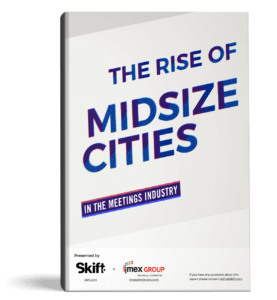This Just In
 A number of factors — such as smaller budgets, and delegates who want a different, more authentic experience — are giving corporate event planners more reasons to consider smaller cities, such as Bristol, Stuttgart, Rotterdam, or Strasbourg, as host destinations.
A number of factors — such as smaller budgets, and delegates who want a different, more authentic experience — are giving corporate event planners more reasons to consider smaller cities, such as Bristol, Stuttgart, Rotterdam, or Strasbourg, as host destinations.
This shift in industry buying habits is highlighted in a new report examining ‘The Rise of Midsize Cities in the Meetings Industry’ in North America and Europe, commissioned by the IMEX Group and developed by Skift.
According to the report, many events are getting priced out of major cities, as rates for hotel rooms, meeting venues, food and beverage, and other services increase every year. Midsize cities are more affordable and have made themselves more appealing by investing heavily in urban revitalization, events infrastructure, and transport links. At the same time, they’re individually refocussing their branding messages to highlight sector strengths — especially in high-tech and creative industries — and are promoting the availability of local leaders in those sectors as exhibitors, sponsors, and speakers.
“This is not to suggest that the big, established cities are lacking — they’re clearly not,” said IMEX CEO Carina Bauer. “Instead, this report reveals why and how smaller cities — defined as less than one million citizens — have started to find new ways to gain traction, add value to their communities, and attract business. They’re frequently working with city leaders and entrepreneurs in very innovative ways, and collaborating with more intention to build a positive legacy. There are important lessons here for every part of the supply chain.”
Midsize cities are rising on the global meetings stage because, as well as providing a more complete package for planners at much more affordable rates, they also offer a far more personal service. As the report points out, “it’s a lot easier to get the Mayor of Long Beach, California to welcome your group, versus the Mayor of Los Angeles. And a meeting in Liverpool or Newcastle can cost 30-40-percent less than a program in London.”
“There are a lot of benefits for meeting in midsize cities,” said Neil Mulligan, senior future host manager, UBM. “You can get the backing of the mayor and access to more stakeholders, whereas big cities won’t get involved to that degree. Attendees also feel like they own the city, and you can brand a midsize city more easily. So, smaller cities need to shout out the attributes of being small.”
According to Greg Oates, executive editor, SkiftX, “The big shift today is that midsize cities are leveraging their size as an advantage now, versus something they need to overcome. That’s based on the widespread improvements in their downtown cores, the exponential rise of industry sector expertise beyond the big gateway cities, and the demand for more affordable, diverse, and unique destinations.”

Newcastle, England
Being able to walk from one side of a midsize city centre to the other makes it easier to really get to know the city — to feel its unique vibe and this level of authenticity makes it easier to create a different experience for delegates. Going somewhere different is especially attractive to younger delegates, who, according to Erin Scholes, president of SD Meetings & Events in San Diego, are more likely to repeat-attend a conference if it is hosted in a different location. “When we do repeat destinations, we don’t see as much repeat attendance,” Scholes said. “One of my groups is educators, and the teachers tend to be more in their 20s and 30s, and when we go to new destinations we tend to see them return.”
The report also points out that midsize cities are collaborating with their ambassadors more intentionally than large cities, helping to attract new conference business and assisting planners in developing more sophisticated event programmes. They’re working harder, because they know that if they deliver the detail, quality, and flexibility that planners need, at a considerably reduced cost, then it’s worth the extra traveling to time to reach a midsize city.
However, there’s a reality the industry must consider if this trend of empowered and viable midsize cities continues — and there’s no reason for it not to. The world only has so much corporate event business to go round and there are a lot more smaller destinations than there are large; many more destinations may soon be competing for the same level of business-event spend, which suggests that in the near future, we’re going to have to find new uses for a lot of empty hotels and venues across Europe and North America.

